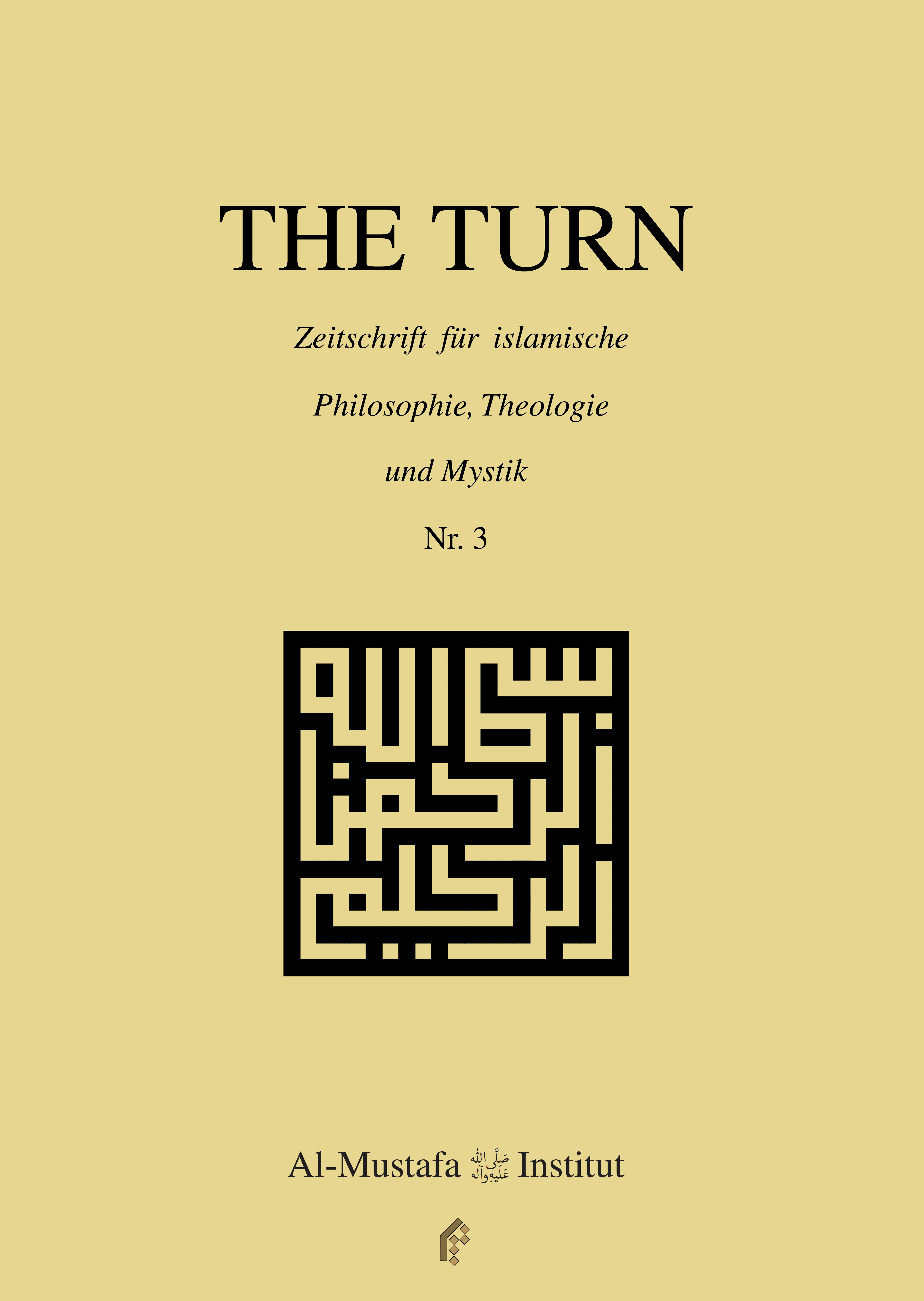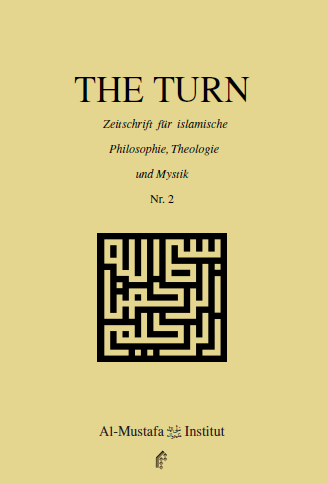Abstracts Daniel Krochmalnik: Experiment Human – On early concentration camp testimony The atrocities that the prisoners in the concentration and extermination camps actually suffered in the 20th century can hardly be understood by outsiders like us today, especially...
Erste Ausgabe – „Sinn und Unsinn“
The Turn ist eine Zeitschrift für islamische Philosophie, Theologie und Mystik.
Über die Ausgabe

Herausgeber
Al-Mustafa Institut Berlin
Redaktion
Michael Nestler
Prof. Dr. Mahdi Esfahani
Wissenschaftlicher Beirat
Prof. Dr. Christoph Böhr
Prof. Dr.Wolfgang Gantke
Prof. Dr.Peter Gerdsen
Prof. Dr. Eveline Goodman-Thau
Prof. Dr. Harald Seubert
Prof. Dr. Hamid Reza Yousefi
Inhalt
Vorwort
In der ersten Ausgabe zum Thema "Sinn und Unsinn" nähern sich die Autoren diesen beiden Begrifflichkeiten auf unterschiedliche Art und Weise und unternehmen ihrerseits den Versuch einer Definition.
- Mahdi Esfahani beschäftigt sich mit seinem Artikel "An den Grenzen des Sinns - Ist Unbegrenztheit gleichbedeutend mit Unsinn?" mit der höchsten Form von Sinn und Sinnhaftigkeit, nämlich Gott. Dabei wird Gott unbegrenzt verstanden, woraus sich die Frage nach seiner Unbegrenztheit stellt und welche epistemologischen Konsequenzen sich hieraus für eine Gotteserfahrung ergeben.
- Marc Hieronimus versucht in seinem Artikel "Wachstumswahnsinn - Vor und Nachdenker der Philosophie des Rückgangs" zu verdeutlichen, dass der technologische Fortschritt trotz seines augenscheinlichen Nutzen für die Menschheit durchaus eine Vielzahl an unsinnigen Gefahren birgt. Er stellt wichtige Vor- und Nachdenker einer Bewegung vor, die sich "Décroissance" nennt und für eine "Philosophie des Rückgangs" plädiert.
- Hamid Reza Yousefi zeigt, dass die Suche nach Sinn einer tiefen Sehnsucht entspringt. In seiner Begriffsgeschichte zu "Was ist Sehnsucht?" sucht er eine Antwort bei verschiedenen Künstlern und Denkern, die die Geistesgeschichte bedeutsam geprägt haben, wobei Sehnsucht in den verschiedenen Epochen unterschiedlich aufgefasst und definiert wird.
- Lutz Richter-Bernburg macht sich basierend auf drei Fragen Immanuel Kants über das Verhältnis zwischen Religion und Wissenschaft Gedanken, nämlich "was kann ich wissen? Was soll ich tun? Was darf ich hoffen?". Sein Artikel "Aggiornamento oder Irrelevanz" beleuchtet er die Rolle hinsichtlich ihrer Sinnproduktion und hinterfragt ihren exklusiven Anspruch auf Wahrheit.
- Timotheus Schneidgger beschäftigt sich in seinem Artikel "Angesichts des Absurden - Von der metaphysischen Revolte zur islamischen Revolution" mit dem Begriff der "Revolte" aus der Sicht des Philosophen Albert Camus und überträgt ihn auf die Ereignisse de Islamischen Revolution 1979 im Iran. Dabei verleiht er dem Begriff der Revolte eine metaphysischen Bedeutung und entwickelt daraus eine "Ethik der Solidarität und der Auflehnung gegen das menschliche Schicksal, die aufzeigt, wie die postmoderne Sinnleere zu überwinden ist".
- Akin Emanuel Sipal wirft einen Blick auf eine Zeit, die irgendwo zwischen Osmanischen Reich, Industrialisierung und Aufbruch in die Moderne verlorengegangen zu sein scheint. Anlass zu einer persönlichen Reflexion über seinen Ur-Ur-Großvater, der 1918 vor den Briten in Istanbul fliehen musste, behandelt er das Gefühl des Abgetrennt-Sein und die Sehnsucht nach dem Ursprung und der Vereinigung mit dem Ganzen. Dabei nimmt er Bezug auf Walter Benjamin, den europäischen "Flaneur" als einen "Suchenden ohne weltliches Ziel" und vergleicht ihn mit den orientalischen Sufis und deren Suche nach Gott.
Mahdi Esfahani: At the limit of meaning
Marc Hieronimus: Madness of growth
Marc Hieronimus: Madness of growth
The progress of technology is considered by the majority as a reasonable endeavor. Nevertheless, the author tries to show that technological progress, in spite of its benefits, causes a variety of absurd dangers because of its uncontrolled growth. The author introduces the leading thinkers of a movement known as “Decroissance” which argues for a “philosophy of degrowth”. Degrowth means the undoing of technological growth and demands an end of its philosophy of “faster, wider, higher and more”. A destructive power can be seen in this, causing overexploitation in nature as well as the annihilation of humankind, not just by the machinery of war. Indeed, in view of the ecological and economical crises of our time, such as species extinction, the contaminations of the soil, the air and the sea, climate change and its impact on many societies, military conflicts due to scarce resources, then a return to more simplicity, frugality and reserve seems quite reasonable and absolutely essential in order to put an end to the madness. Hence the idea of “Decroissance” is quite relevant today and this article gives an instructive overview.
Hamid Reza Yousefi: What is desire?
Hamid Reza Yousefi: What is desire?
The searching after meaning arises from a deep desire of mankind. The question “What is desire?” is answered by various artists and thinkers who significantly shaped and developed intellectual history. Desire has been considered and defined differently during the various ages, whether as an attempt to compensate for a personal deficit or as a feeling of being drawn towards the opposite gender. This article also looks at the eras of Enlightenment and Romanticism, covering not only the understanding of desire, but also the different forms of expression used to treat the question of desire: for Example in the painting entitled “Wanderer above the Sea of Fog” (translated into English) by Caspar David Friedrich and the symbol of “The Blue Flower” in the painting of Phillip Otto Runge, but also the fairy tales of the Brothers Grimm, we can see that the feeling of desire has continuously evolved. It arises from the soul of a primal desire which is the engine of all the creative activities.
Lutz Richter-Bernburg: Aggiornamento or irrelevance
Lutz Richter-Bernburg: Aggiornamento or irrelevance
By means of the three questions “what can I know, what shall I do, what may I hope”, which can be traced back to Immanuel Kant, this article highlights the role of religion concerning in generating meaning and questions its exclusive claim to truth. Especially when dealing with the written religious heritage the author sees the need for a critical self-questioning on the part of the religions
in view of an awareness of empirical as well as historical human sciences. The author calls for the “self-historicization” and a “humanized enclosure” of the religions. For this purpose, it is necessary to critically analyze the texts and traditions and be willing to say farewell to outdated traditions and interpretations in order to be open for the future of new exegesis, which satisfies the scientific demand. The author takes up a much-discussed Islamic tradition in order to show that Kant’s categorical imperative has also to be applied to religious issues.
Timotheus Schneidegger: In view of the absurd
Timotheus Schneidegger: In view of the absurd
The author outlines the idea of the “revolt”, which was defined metaphysically by the writer and philosopher Albert Camus, and applies this theory to the Islamic Revolution in 1979 in Iran. Camus develops an “ethics of solidarity and revolution” against the destiny of humankind which shows how the postmodern inner void can be overcome. This philosophic theory starts with the experiences of the “absurd”, which arises from the discrepancy between the human demand and the earthly reality. The humankind possesses a metaphysical hunger after meaning, which cannot be sated by the world. This leads to a feeling of strangeness, which acts as the basis of the “revolt”, since one cannot find the expected harmony and satisfaction. The author considers the Islamic Revolution promising to re-establish the holy and giving a new meaning of life to the people. He sees this event as an example of history repeating itself, where the searching after meaning is like the labor of Sisyphus.
Akın Emanuel Sipal: The tortoise trainer
Akın Emanuel Sipal: The tortoise trainer
The author observes a painting of Osman Hamdi Bey about a tortoise trainer, an Ottoman dervish with a bamboo flute. This picture prompts the author for personal reflections about his grand-grandfather, who had to flee in 1918 because of the British invasion in Istanbul. For Rumi the bamboo flute is a symbol of the human being detached from his roots. That feeling of detachment and painful desire for his origin is the main subject of the author. He refers to Walter Benjamin, who described the European flaneurs as searchers without an earthly purpose and compared them with oriental Sufis who search for God. The desire of the author for his roots reveals itself also in his representation of the Ottoman Empire, which is linked to the fortune of his grand-grandfather, who had to give up his life due to the beginning of a new era. Nevertheless, behind all the pain which is caused by every separation, which might be senseless to us, hope, sense and reconciliation arise: “Flaneurs are those sensitive souls exiled by the postmodern who can acquire a sweet taste from all the constituent pain, because they see an universal reality in them.”
Weitere Ausgaben der Zeitschrift
Zweite Ausgabe – „Sprache und Zeichen“
In der Zweiten Ausgabe zum Thema "Sprache und Zeichen" nähern sich die Autoren diesen beiden Begrifflichkeiten auf unterschiedliche Art und Weise und unternehmen ihrerseits den Versuch einer Definition. Roman Singendonk diskutiert in seinem Essay "Die Sprache...
Ausgabe Zero – „Daseinsgrenzen“
Die Ausgabe Zero zum Thema "Daseinsgrenzen" verdeutlicht, wie wir uns die Diskussion um einen coranic turn vorstellen: Stefan Weidner (Köln) zeigt wie ein islamischer Begriff von Fremdheit gegen moderne Fremdenfeindlichkeit gestellt werden kann.Regula...
Kontaktiere uns!



